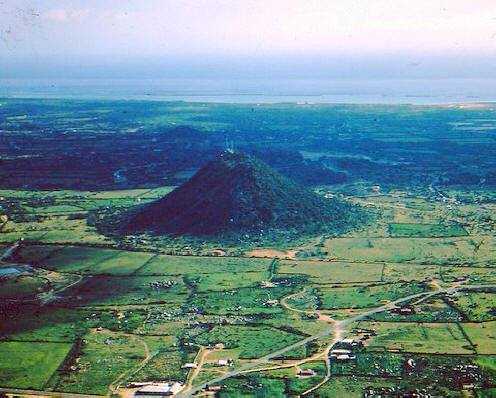Every week we share the most interesting and insightful articles about Aruba as a destination to explore and conserve. Discover amazing and informative stories to enrich your knowledge and experience. There is so much to admire on this tiny island such as the variety of the landscape and its differences which is the result of the weather resistance of different types of rocks.
We can differentiate three basic geological formations. One is a hilly part, second by an undulating part and a third part consisting of limestone which embraces these two zones mentioned before and forming also the coast line.
The landscape of Sta. Cruz, Tanki Flip, Noord area and in the south of Savaneta is mostly flat to slightly undulating with quartz diorite (QD) boulders in it. This rock is has a gray color with dark and light speckled, and is relatively hard. These are many areas with boulders and small or large patches of sand and vegetation. The Hooiberg elevates to166 m, a conical-shaped hill west of Santa Cruz and is situated in the middle of the typical QD landscape. The main component of this hill is of volcanic formation called Hooibergite. Other geological phenomena in the QD landscape are the small hills at the north coast and areas of our by law protected dunes prohibiting the incursion of all types of motorized vehicles.
A curious fact is that our dunes where manly formed by the feeding habits of various types of parrotfish who bites of the living coral to extract the animal juices inside, while spit out the crushed calcium in to a fine sand, that the wind on its part accumulates as dunes behind our north coast beaches.
The dunes are well drained, often dry, and are composed also of calcium carbonate from eroded seashells. Decomposing sea algae, brought in by stormy weather, adds nutrients to allow pioneer species to colonize them.
In these white dunes and desert landscape we find some hardy flora species that are perfectly adapted to the aridity of the soil, the mobility of the loose sandy substrate, the low nutrients and the salinity, elements ideal to sustain the halophyte plant communities that survive in these extreme soil conditions of high saline content.
Some of these pioneering species are the “Sesuvium portulacastrum” or “Tobacco di piscado” (fishermans tabaco), in our native Papiamento, the “cocorobana” “Tournefortia gnaphalodes” also known by the name of “sea lavender” and sea grapes, Cocoloba uvifera. The predominant fauna of these coastal dunes are insects such as bees, wasps and ants, beetles, spider flies, sea birds and also lizards.
As we move away from the sea, the intensity of the wind, the salt spray and the mobility of the substrate are reduced. This makes the environmental conditions less extreme, which is used by a greater number of species.
To get to know a little more regarding Aruba’s and its cultural origins, etc. We highly recommend you to book your participation in our cultural encounter session. A mind opening revelation and entertaining island experience. Whatsapp + 297 5922702 or mail etnianativa03@gmail.com our facilities and activities take place close to high rise hotels.















